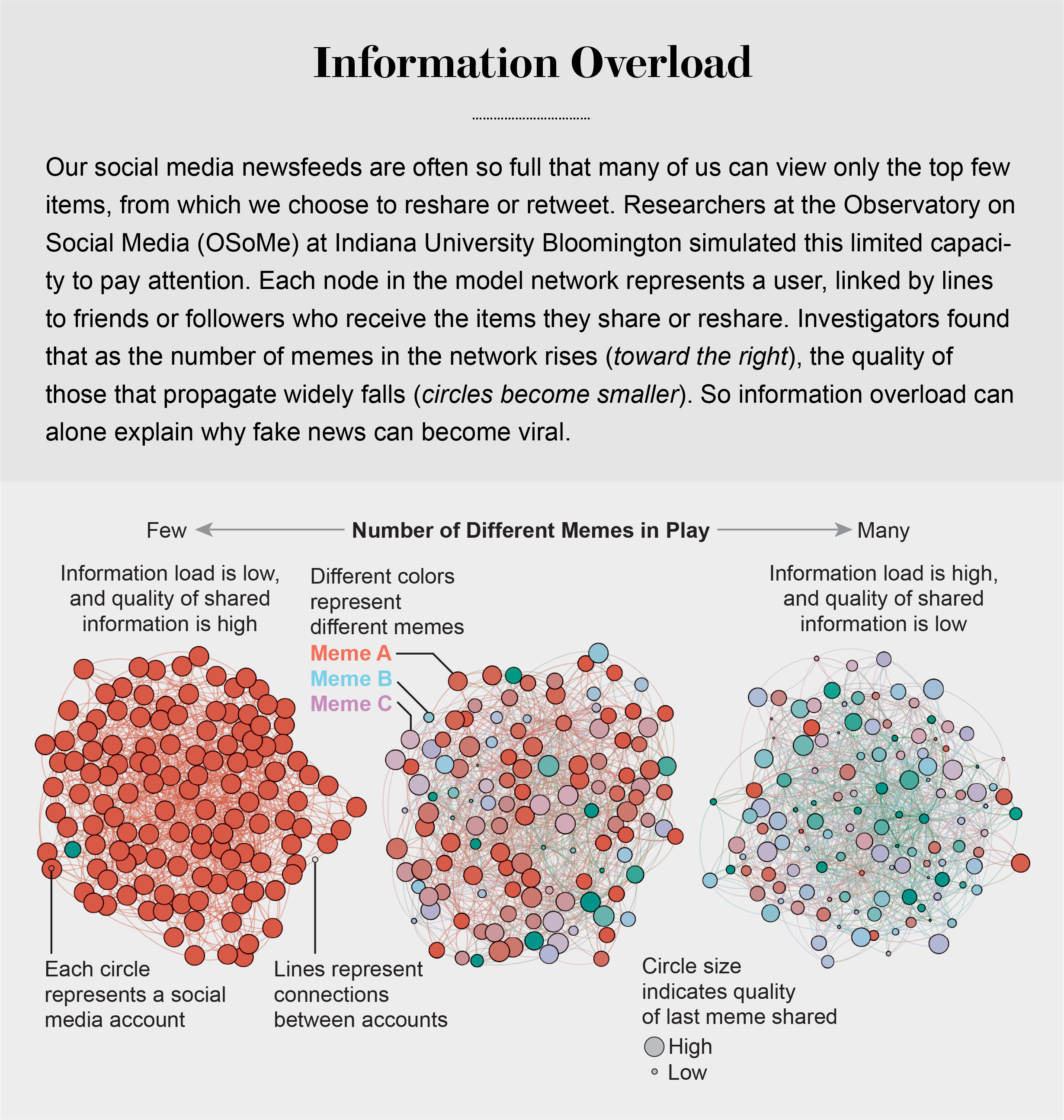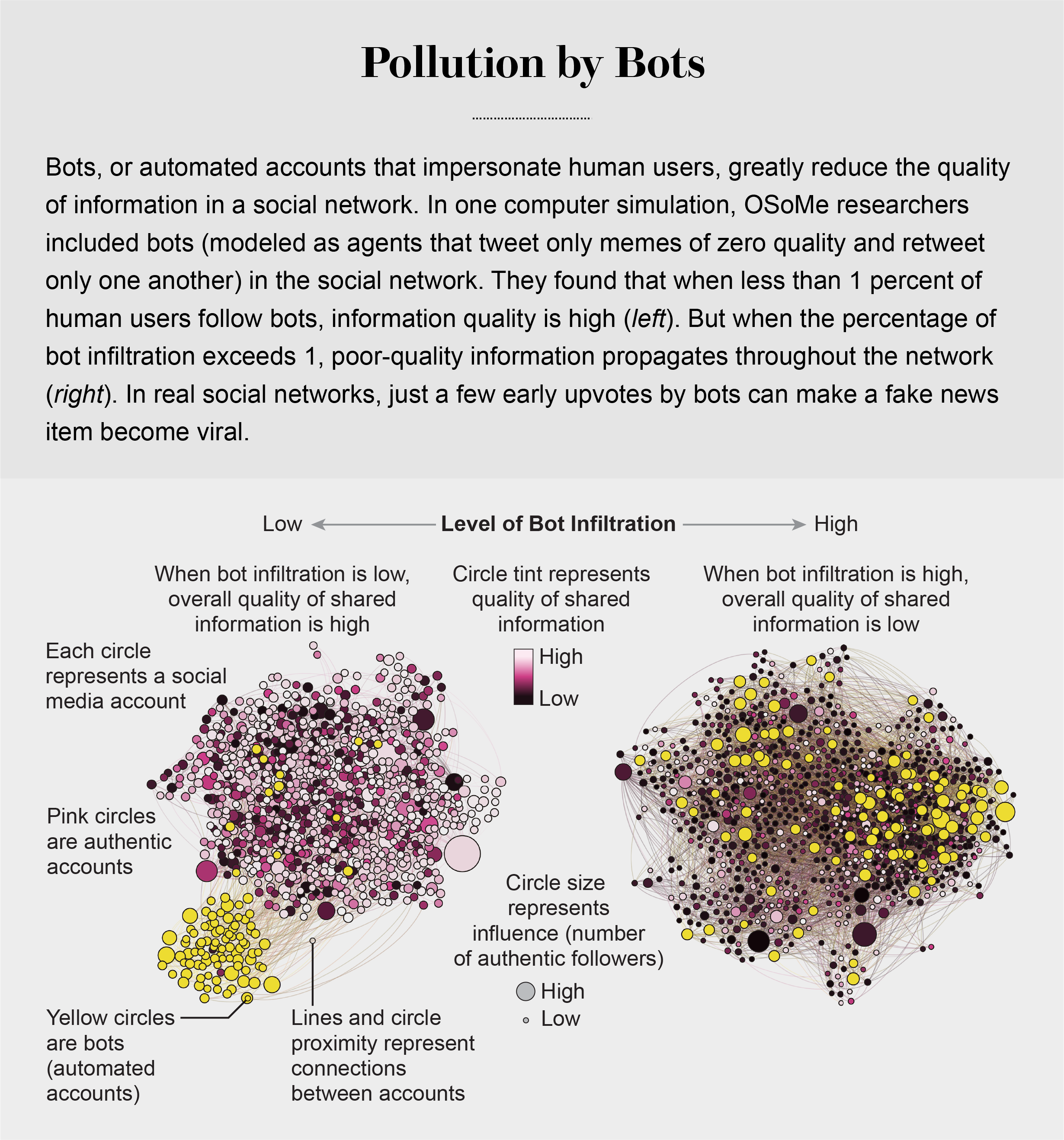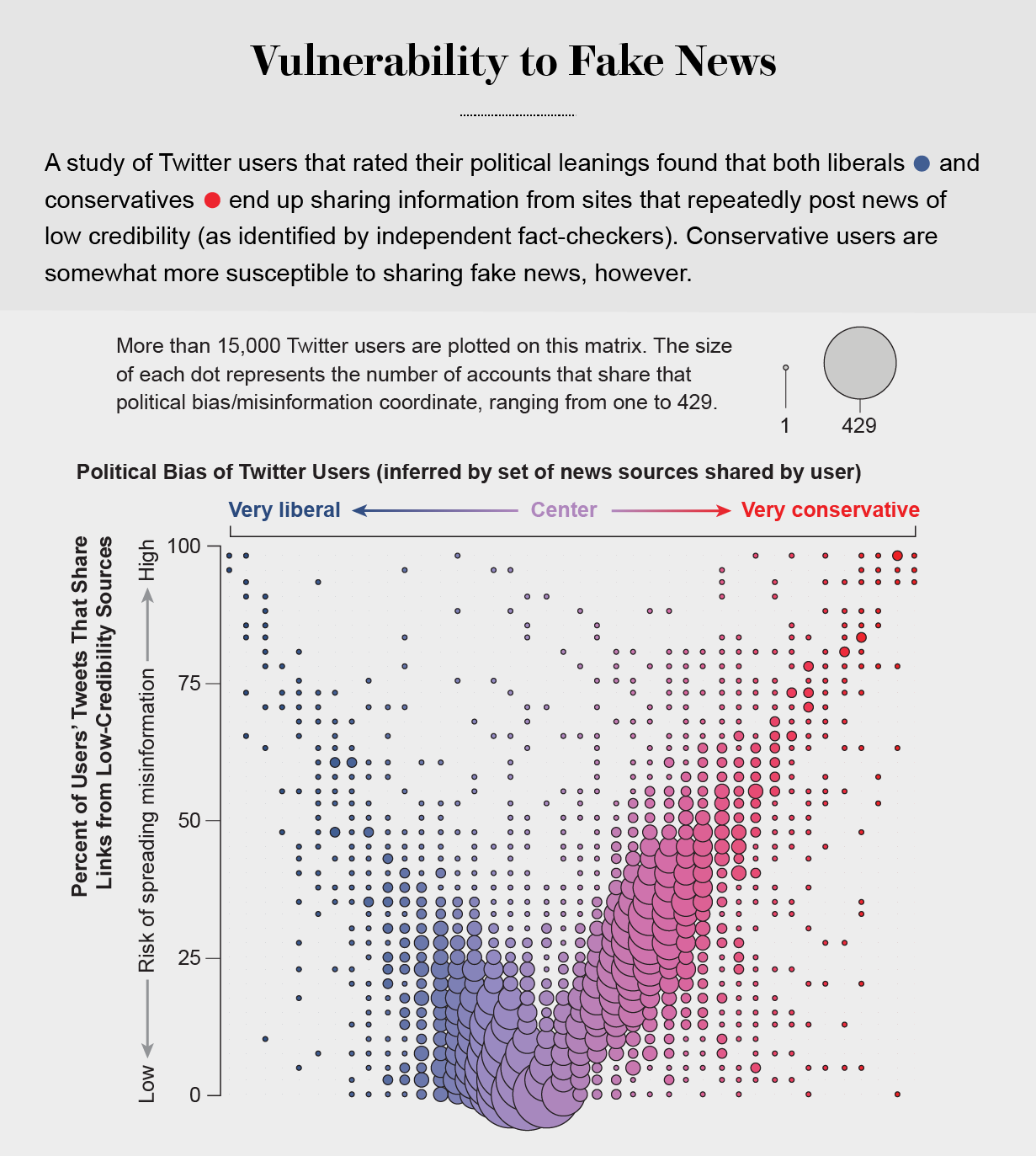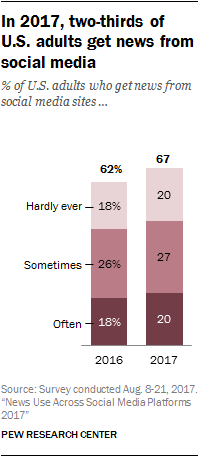Searching for "social media news"
https://bryanalexander.org/digital-literacy/using-social-media-for-news-the-latest-pew-update/
++++++++++
more on SM News in this IMS blog
https://blog.stcloudstate.edu/ims?s=social+media+news
Information Overload Helps Fake News Spread, and Social Media Knows It
Understanding how algorithm manipulators exploit our cognitive vulnerabilities empowers us to fight back
https://www.scientificamerican.com/article/information-overload-helps-fake-news-spread-and-social-media-knows-it/
a minefield of cognitive biases.
People who behaved in accordance with them—for example, by staying away from the overgrown pond bank where someone said there was a viper—were more likely to survive than those who did not.
Compounding the problem is the proliferation of online information. Viewing and producing blogs, videos, tweets and other units of information called memes has become so cheap and easy that the information marketplace is inundated. My note: folksonomy in its worst.
At the University of Warwick in England and at Indiana University Bloomington’s Observatory on Social Media (OSoMe, pronounced “awesome”), our teams are using cognitive experiments, simulations, data mining and artificial intelligence to comprehend the cognitive vulnerabilities of social media users.
developing analytical and machine-learning aids to fight social media manipulation.
As Nobel Prize–winning economist and psychologist Herbert A. Simon noted, “What information consumes is rather obvious: it consumes the attention of its recipients.”
attention economy

Our models revealed that even when we want to see and share high-quality information, our inability to view everything in our news feeds inevitably leads us to share things that are partly or completely untrue.
Frederic Bartlett
Cognitive biases greatly worsen the problem.
We now know that our minds do this all the time: they adjust our understanding of new information so that it fits in with what we already know. One consequence of this so-called confirmation bias is that people often seek out, recall and understand information that best confirms what they already believe.
This tendency is extremely difficult to correct.
Making matters worse, search engines and social media platforms provide personalized recommendations based on the vast amounts of data they have about users’ past preferences.
pollution by bots

Social Herding
social groups create a pressure toward conformity so powerful that it can overcome individual preferences, and by amplifying random early differences, it can cause segregated groups to diverge to extremes.
Social media follows a similar dynamic. We confuse popularity with quality and end up copying the behavior we observe.
information is transmitted via “complex contagion”: when we are repeatedly exposed to an idea, typically from many sources, we are more likely to adopt and reshare it.

In addition to showing us items that conform with our views, social media platforms such as Facebook, Twitter, YouTube and Instagram place popular content at the top of our screens and show us how many people have liked and shared something. Few of us realize that these cues do not provide independent assessments of quality.
programmers who design the algorithms for ranking memes on social media assume that the “wisdom of crowds” will quickly identify high-quality items; they use popularity as a proxy for quality. My note: again, ill-conceived folksonomy.
Echo Chambers
the political echo chambers on Twitter are so extreme that individual users’ political leanings can be predicted with high accuracy: you have the same opinions as the majority of your connections. This chambered structure efficiently spreads information within a community while insulating that community from other groups.
socially shared information not only bolsters our biases but also becomes more resilient to correction.
machine-learning algorithms to detect social bots. One of these, Botometer, is a public tool that extracts 1,200 features from a given Twitter account to characterize its profile, friends, social network structure, temporal activity patterns, language and other features. The program compares these characteristics with those of tens of thousands of previously identified bots to give the Twitter account a score for its likely use of automation.
Some manipulators play both sides of a divide through separate fake news sites and bots, driving political polarization or monetization by ads.
recently uncovered a network of inauthentic accounts on Twitter that were all coordinated by the same entity. Some pretended to be pro-Trump supporters of the Make America Great Again campaign, whereas others posed as Trump “resisters”; all asked for political donations.
a mobile app called Fakey that helps users learn how to spot misinformation. The game simulates a social media news feed, showing actual articles from low- and high-credibility sources. Users must decide what they can or should not share and what to fact-check. Analysis of data from Fakey confirms the prevalence of online social herding: users are more likely to share low-credibility articles when they believe that many other people have shared them.
Hoaxy, shows how any extant meme spreads through Twitter. In this visualization, nodes represent actual Twitter accounts, and links depict how retweets, quotes, mentions and replies propagate the meme from account to account.
Free communication is not free. By decreasing the cost of information, we have decreased its value and invited its adulteration.
++++++++
more on social media in this IMS blog
https://blog.stcloudstate.edu/ims?s=social+media
Election Strife, Protest And Noise: In 2017, Russia Cranked Up The Volume
“They were taking both sides of the argument this past weekend and pushing them out from their troll farms as much as they could to just raise the noise level in America and make a big issue seem like an even bigger issue as they’re trying to push divisiveness in the country,” as Sen. James Lankford, R-Okla.,
said in the fall.
The Trump administration detailed the threat — without any specific mention of the 2016 interference — in
the new National Security Strategy it released at the end of December.
++++++++++++
The Russian Facebook scandal damages liberals as much as the right
The Republicans might have been tarnished by the St Petersburg troll factory, but Democratic fantasies about social media were rubbished in the process
The ads in question were memes, manufactured and posted to a number of bluntly named, pseudo-American
Facebook accounts in 2016 by workers at a troll farm in St Petersburg, Russia. There were thousands of these ads, it seems, plus parallel efforts on Instagram and Twitter. Between them, they reached over 100 million people.
The memes were
big news for a while because they showed what Russian interference in the 2016 election actually looked like, in vivid color. Eventually the story faded, though, in part because it was superseded by other stories, but also, I think, because the Russian ad story was deeply distasteful to both sides of our atrophied political debate.
The ads were clumsily written. They were rife with spelling errors and poor grammar. Their grasp of American history was awful. And
over them all hovered a paranoid fear that the powerful were scheming to flip the world upside-down in the most outlandish ways: to turn our country over to the undocumented … to punish the hardworking … to crack down on patriots and Christians … to enact Sharia law right here at home.
The social media platforms aren’t neutral arbiters, selflessly serving the needs of society. As is all too obvious now, they are monopolies that manipulate us in a hundred different ways, selecting our news, steering us towards what we need to buy. The corporate entities behind them wield enormous power in Washington, too,
filling Democratic campaign coffers and keeping the revolving door
turning for trusted servants. Those who don’t comply get
disciplined.++++++++++++++
Internet watchdog demands explanation after Ramzan Kadyrov claimed Facebook also suspended him without explanation
https://www.theguardian.com/world/2017/dec/26/chechnya-ramzan-kadyrov-social-media-russia-instagram-facebook
Kadyrov has accused the US government of pressuring the social networks to disable his accounts, which he said were blocked on Saturday without explanation. The US imposed travel and financial sanctions on Kadyrov last week over numerous allegations of human rights abuses.
The former rebel fighter, who is now loyal to the Russian president, Vladimir Putin, is a fan of social media, particularly Instagram, which he has used in recent years to make barely veiled death threats against Kremlin critics.
Leonid Levin, the head of the Russian parliament’s information technologies and communications committee, suggested the move by Facebook and Instagram was an attack on freedom of speech.
Dzhambulat Umarov, the Chechen press and information minister, described the blocking of Kadyrov’s accounts as a “vile” cyber-attack by the US.
Neither Instagram nor Facebook had commented at the time of publication.
In 2015, Kadyrov urged Chechen men not to let their wives use the WhatsApp messaging service after an online outcry over the forced marriage of a 17-year-old Chechen to a 47-year-old police chief. “Do not write such things. Men, take your women out of WhatsApp,” he said.
++++++++++
more on fake news in this IMS blog
https://blog.stcloudstate.edu/ims?s=fake+news
News Use Across Social Media Platforms 2017
BY ELISA SHEARER AND JEFFREY GOTTFRIED SEPTEMBER 7, 2017
http://www.journalism.org/2017/09/07/news-use-across-social-media-platforms-2017/

Furthermore, about three-quarters of nonwhites (74%) get news on social media sites, up from 64% in 2016.
Twitter, YouTube and Snapchat have grown in share of users who get news on each site.
Twitter, YouTube and Snapchat have grown in share of users who get news on each site
More Americans now get news on multiple social media sites
Snapchat has by far the youngest group of news users – 82% are ages 18-29. While Facebook and YouTube are still the most popular among this age group for news overall, the makeup of the app’s news audience means that about one-in-five (21%) 18- to 29-year-olds now get news on Snapchat.
Many social media news consumers still get news from more traditional platforms

++++++++++++++++++++++
more on social media in this IMS blog
https://blog.stcloudstate.edu/ims?s=social+media
One of China’s biggest social networks is revealing user locations to head off ‘bad behaviour’
https://www.techradar.com/news/one-of-chinas-biggest-social-networks-is-revealing-user-locations-to-head-off-bad-behaviour
euters reports that Weibo will begin showing the rough locations of its users using IP addresses to combat “bad behaviour” online. The locations show up on both profiles and posts.
Chinese citizens have long resorted to using VPNs and other privacy tools to help either access non-Chinese services or speak freely online and you can see why.
In a similar view to the Panopticon, visibly showing users that the service knows where they are will lead to self-censorship, reducing the strain on Chinese censors to cover an internet with hundreds of millions of users.
+++++++++++++++
more on social credit system in this IMS blog
https://blog.stcloudstate.edu/ims?s=china+social
Critical news literacy session for social policy analysis course
Katie Querna, Thursday, 11AM, Stewart Hall

https://www.theguardian.com/world/2022/feb/21/dumb-and-lazy-the-flawed-films-of-ukrainian-attacks-made-by-russias-fake-factory
https://english.elpais.com/science-tech/2022-02-24/the-war-in-ukraine-via-tiktok-how-ordinary-citizens-are-recording-russian-troops.html
+++ please cover this information at home and bring your ideas and questions to class +++++
Most students can’t tell fake news from real news, study shows
Read more: https://blog.stcloudstate.edu/ims/2017/03/28/fake-news-3/
Module 1 (video to introduce students to the readings and expected tasks)
- Fake News / Misinformation / Disinformation
- Definitions
- Fake news, alternative facts
https://blog.stcloudstate.edu/ims?s=fake+news
https://blog.stcloudstate.edu/ims?s=alternative+facts
- Misinformation vs disinformation
https://blog.stcloudstate.edu/ims/2018/02/18/fake-news-disinformation-propaganda/
- Propaganda
- Conspiracy theories
- Bots, trolls
https://blog.stcloudstate.edu/ims/2017/11/22/bots-trolls-and-fake-news/
https://blog.stcloudstate.edu/ims/2020/04/30/fake-social-media-accounts-and-politicians/
https://blog.stcloudstate.edu/ims/2020/01/20/bots-and-disinformation/
- Clickbait
Filter bubbles, echo chambers
(8 min) video explains filter bubbles
https://www.ted.com/talks/eli_pariser_beware_online_filter
+++++ thank you for covering this information at home. Pls don’t forget to bring your q/s and ideas to class +++++
Why we are here today?
We need to look deeper in the current 21stcentury state of information and disinformation and determine how such awareness can help policy analysis.
How do we make up our mind about news and information; where from we get our info; who do we believe, who do we mistrust.
What do you understand under the following three items and their place in our efforts to analyze policies?
“critical thinking,” https://blog.stcloudstate.edu/ims/2014/05/11/the-5-step-model-to-teach-students-critical-thinking-skills/
“media literacy,” “Media Literacy now considers digital citizenship as part of media literacy — not the other way around”
https://blog.stcloudstate.edu/ims/2020/01/07/k12-media-literacy/
“critical [news] literacy”
https://youtu.be/i2WyIkK9IOg
how do these three items assist a better analysis of policies?
Class assignment:
Share a topic which is very much to your heart.
Please feel welcome to use the following resources and/or contribute with your own resources to determine the sources and potential bias
library spot fake news
fake news resources
fake news and video
Feel free also to use the following guidelines when establishing the veracity of information:
Here is a short (4 min) video introducing you to the well-known basics for evaluation of academic literature:
https://youtu.be/qUd_gf2ypk4
- ACCURACY
- Does the author cite reliable sources?
- How does the information compare with that in other works on the topic?
- Can you determine if the information has gone through peer-review?
- Are there factual, spelling, typographical, or grammatical errors?
- AUDIENCE
- Who do you think the authors are trying to reach?
- Is the language, vocabulary, style and tone appropriate for intended audience?
- What are the audience demographics? (age, educational level, etc.)
- Are the authors targeting a particular group or segment of society?
- AUTHORITY
- Who wrote the information found in the article or on the site?
- What are the author’s credentials/qualifications for this particular topic?
- Is the author affiliated with a particular organization or institution?
- What does that affiliation suggest about the author?
- CURRENCY
- Is the content current?
- Does the date of the information directly affect the accuracy or usefulness of the information?
- OBJECTIVITY/BIAS
- What is the author’s or website’s point of view?
- Is the point of view subtle or explicit?
- Is the information presented as fact or opinion?
- If opinion, is the opinion supported by credible data or informed argument?
- Is the information one-sided?
- Are alternate views represented?
- Does the point of view affect how you view the information?
- PURPOSE
- What is the author’s purpose or objective, to explain, provide new information or news, entertain, persuade or sell?
- Does the purpose affect how you view the information presented?
In 2021, however, all suggestions above may not be sufficient to distinguish a reliable source of information, even if the article made it through the peer-reviewed process. In time, you should learn to evaluate the research methods of the authors and decide if they are reliable. Same applies for the research findings and conclusions.
++++++++++++++++++++
Aditional topics and ideas for exploring at home:
civil disobedience
https://blog.stcloudstate.edu/ims/2014/09/30/disruptive-technologies-from-swarming-to-mesh-networking/
https://blog.stcloudstate.edu/ims/2019/08/30/tik-tok-students-and-teachers/
https://news.softpedia.com/news/Venezuela-Blocks-Walkie-Talkie-App-Zello-Amid-Protests-428583.shtml
http://www.businessinsider.com/yo-updates-on-israel-missile-attacks-2014-7
https://blog.stcloudstate.edu/ims/2016/11/14/internet-freedom/
https://blog.stcloudstate.edu/ims/2016/08/31/police-to-block-social-media/
https://blog.stcloudstate.edu/ims/2016/04/04/technology-and-activism/
The 3rd Era of Social Is Coming. Are You Ready?
https://www.linkedin.com/pulse/3rd-era-social-coming-you-ready-joe-lazauskas/
The News Feed made Facebook an actual social network. In turn, the News Feed became synonymous with social media.
Twitter’s feed was chronological, so you could tweet out a ton of links to content and get consistent clicks from your followers. Facebook’s algorithm was incredibly friendly to “link posts” that sent users to news or blog articles.
Stories let Snapchat users post a series of snaps that would last for 24 hours, and it was an immediate hit.
Stories were so absurd on LinkedIn that the company is shutting it down by the end of this month).
TikTok’s success has often been attributed to its algorithm, which is very good at predicting the type of video you’ll like. But TikTok is also so successful because it plays on the same part of our brain that makes gambling so addictive. random reinforcement
As our research showed earlier this year, people will continue to consume content in an array of different formats—from blog posts to YouTube to podcasts to good old-fashioned memes.
Media, Technology and Education in a Post-Truth Society
https://www.emerald.com/insight/publication/doi/10.1108/9781800439061
Alexander, B. (2021), “Macroauthorities and Microliteracies: The New Terrain of Information Politics”, Grech, A. (Ed.) Media, Technology and Education in a Post-Truth Society (Digital Activism and Society: Politics, Economy And Culture In Network Communication), Emerald Publishing Limited, Bingley, pp. 29-37. https://doi.org/10.1108/978-1-80043-906-120211003
Portelli, J.P. and Oladi, S. (2021), “Post-truth Society: Toward a Dialogical Understanding of Truth”, Grech, A. (Ed.) Media, Technology and Education in a Post-Truth Society (Digital Activism and Society: Politics, Economy And Culture In Network Communication), Emerald Publishing Limited, Bingley, pp. 11-28. https://doi.org/10.1108/978-1-80043-906-120211002
Patrinos, H.A. (2021), “The Learning Challenge in the Twenty-first Century * “, Grech, A. (Ed.) Media, Technology and Education in a Post-Truth Society (Digital Activism and Society: Politics, Economy And Culture In Network Communication), Emerald Publishing Limited, Bingley, pp. 39-53. https://doi.org/10.1108/978-1-80043-906-120211004
Pauncefort, E. (2021), “Critical Literacy Is at the Heart of the Answer”, Grech, A. (Ed.) Media, Technology and Education in a Post-Truth Society (Digital Activism and Society: Politics, Economy And Culture In Network Communication), Emerald Publishing Limited, Bingley, pp. 73-94. https://doi.org/10.1108/978-1-80043-906-120211006
Balser, W.F., Diasio, S. and Kendal, T. (2021), “Societal Reorientation via Programmable Trust: A Case for Piloting New Models of Open Governance in Education”, Grech, A. (Ed.) Media, Technology and Education in a Post-Truth Society (Digital Activism and Society: Politics, Economy And Culture In Network Communication), Emerald Publishing Limited, Bingley, pp. 95-110. https://doi.org/10.1108/978-1-80043-906-120211007
This essay proposes the need to infuse open innovation (OI) and open source (OS) principles and technologies into schools as a means of tackling many of the most pervasive challenges in education, and by extension, society at large. It is argued that the principles of OI and OS, which are rooted in innovation management and software development, respectively, may be applied to the way we conceive of and approach organizational governance structures related to schooling, particularly in regard to harnessing innovation, updating management processes, and codifying new systems of trust. Whereas OI offers a novel approach to knowledge flow and the open exchange of ideas, communities rooted in OS principles breed tangible and generative effects through peer network democratization. These emergent, digitally defined networks have been proven to maximize innovation potential, expand collaboration, and enable the propagation of highly durable systems of trust and transparency, all catalytic and essential if we are to realize a future learning economy which favors equity, distributed systems, and common goods over profit, centralized decision-making, and proprietorship. It is within this framing that we articulate the core tenets of both OI and OS translationally as a means of stimulating thinking about how core principles of “openness” and the distributed technologies they enable may help to build common ground in an ever-evolving education and information ecosystem.
Sant, T. (2021), “How Can Wikipedia Save Us all?: Assuming Good Faith from all Points of View in the Age of Fake News and Post-truth”, Grech, A. (Ed.) Media, Technology and Education in a Post-Truth Society (Digital Activism and Society: Politics, Economy And Culture In Network Communication), Emerald Publishing Limited, Bingley, pp. 133-143. https://doi.org/10.1108/978-1-80043-906-120211010
Fusari, M. (2021), “The Kony 2012 Campaign: A Milestone of Visual Storytelling for Social Engagement”, Grech, A. (Ed.) Media, Technology and Education in a Post-Truth Society (Digital Activism and Society: Politics, Economy And Culture In Network Communication), Emerald Publishing Limited, Bingley, pp. 155-173. https://doi.org/10.1108/978-1-80043-906-120211012
Mallia, Ġorġ. (2021), “Post-truth Visuals, Untruth Visuals”, Grech, A. (Ed.) Media, Technology and Education in a Post-Truth Society (Digital Activism and Society: Politics, Economy And Culture In Network Communication), Emerald Publishing Limited, Bingley, pp. 175-187. https://doi.org/10.1108/978-1-80043-906-120211013
Basu, D. and Gabbay, M. (2021), “Karl Marx and the Blockchain”, Grech, A. (Ed.) Media, Technology and Education in a Post-Truth Society (Digital Activism and Society: Politics, Economy And Culture In Network Communication), Emerald Publishing Limited, Bingley, pp. 225-241. https://doi.org/10.1108/978-1-80043-906-120211016
Blockchain is often presented as a technological development; however, clearly it is not only that: the ‘Blockchain buzz’ exists in the context of current social and political developments. In this essay, we analyse blockchain technology and its social and political context from a perspective of Marxist economic theory. Since arguably the last great inflection point in society and technology was analysed by Marx in terms of labour and capital and since we seem to be experiencing a shift in the balance between these forces today, it makes sense to revisit the Marxist ideas and apply them to the current situation, to see how well they still apply and if necessary to update them for current events.
Ellul, J., Grech, A. and Pace, G.J. (2021), “Two Sides to Every Story. The Truth, Post-truth, and the Blockchain Truth”, Grech, A. (Ed.) Media, Technology and Education in a Post-Truth Society (Digital Activism and Society: Politics, Economy And Culture In Network Communication), Emerald Publishing Limited, Bingley, pp. 243-253. https://doi.org/10.1108/978-1-80043-906-120211017
One of the rallying cries of the blockchain community is that of immutability: the irreversibility of the past, the absolute truth which, once stored, remains there forever. The technology was designed with this foundational pillar in mind to ensure that changes to history are inordinately expensive and practically impossible to execute – and increasingly so, the further in the past the event which one intends to manipulate lies. This platonic view of absolute truth is in stark contrast with a world of manipulated truth, and it is not surprising that it is being revisited as a means of combating fake news. We argue that claims to the absolute nature of the blockchain are at best exaggerated, at worst misrepresented or even ‘fake news’. We discuss implicit centralised points of trust in blockchains, whether at a technological, social or governance level, and identify how these can be a threat to the ‘immutable truth’ stored within the blockchain itself. A global pandemic has unleashed an unprecedented wave of contradictory positions on anything from vaccines and face masks to ‘the new normal’. It is only natural that the pursuit of blockchain as a placebo for society’s ‘truth’ problems continues.
Teaching Crowds: Learning and Social Media by Jon Dron and Terry Anderson Published by Athabasca University, Canada, ISBN: 978-1-927356-81-4 (PDF), September 2014, Pages: 370
(book review)
https://www.dhakacourier.com.bd/news/Essays/Using-social-media-platforms-in-teaching-learning/1051
Dr. Jon Dron and Professor Terry Anderson of Athabasca University, Canada attempt to introduce a new model for understanding and exploiting the pedagogical potential of Web-based technologies. Recognizing the E-learning/ online education as new model of teaching and learning, the authors show how learners can engage with social media platforms to create an unbounded field of emergent connections.
In chapter 9 ‘Issues and Challenges in Educational Uses of Social Software’ , the writers accordingly examine the dark side of social software—the ways in which it can undermine or even jeopardize, rather than deepen and extend, the experience of learning. They present a series of over-arching issues that warrant consideration by anyone who plans to use social software for learning. These include issues surrounding privacy, disclosure, and trust, cross-cultural dissonances, problems posed by the complexities of technology and by the digital divide, unpredictable systemic effects, and risks such as mob stupidity and filter bubbles.
+++++++++++++++
more on social media in this IMS blog
https://blog.stcloudstate.edu/ims?s=social+media





